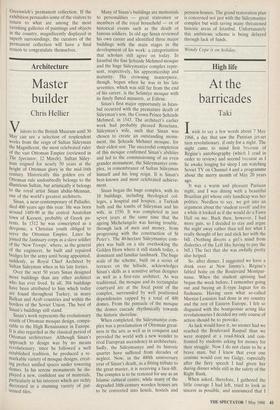Architecture
Master builder
Chris Hellier
Visitors to the British Museum until 30 May can see a selection of resplendent works from the reign of Sultan SiHeyman the Magnificent, the most celebrated ruler of the vast Ottoman Empire (reviewed in The Spectator, 12 March). Sultan Siiley- man reigned for nearly 50 years at the height of Ottoman glory in the mid-16th century. Historically this golden era of Ottoman rule undoubtedly belongs to the Illustrious Sultan, but artistically it belongs to the royal artist Sinan abdiir-Mennan, one of the world's greatest architects.
. Sinan, a near-contemporary of Palladio, died 400 years ago this year. He was born around 1489-90 in the central Anatolian town of Kayseri, probably of Greek pa- rents. In 1512 he was conscripted as a dev§irme, a Christian youth obliged to serve the Ottoman Empire. Later he Joined the Janissary corps as a slave soldier of the 'New Troops', where, as the general of the engineers, he built and repaired bridges for the army until being appointed, suddenly, as Royal Chief Architect by Sultan Stileyman when in his late forties.
Over the next 50 years Sinan designed more buildings than any other architect who has ever lived. In all, 304 buildings have been attributed to him which today are found throughout Turkey, in many Balkan and Arab countries and within the borders of the Soviet Union. The best of Sinan's buildings still stand.
Sinan's work represents the evolutionary zenith of Ottoman mosque design, compa- rable to the High Renaissance in Europe. It is also regarded as the classical period of Ottoman architecture. Although Sinan's approach to design was by no means revolutionary, since he followed a well established tradition, he produced a re- markable variety of mosque designs, creat- ing perfect unified spaces under towering domes. In his serene monuments he dis- played a new, confident use of materials, Particularly in his interiors which are richly decorated in a stunning variety of pat- terned tiles. Many of Sinan's buildings are memorials to personalities — great statesmen or members of the royal household — or of historical events such as the death of famous soldiers. In old age Sinan reviewed his own career and identified three major buildings with the main stages in the development of his work: a categorisation that scholars still agree on today. In Istanbul the fine Sehzade Mehmed mosque and the huge Siileymaniye complex repre- sent, respectively, his apprenticeship and maturity. His crowning masterpiece, though, begun when he was in his late seventies, which was still far from the end of his career, is the Selimiye mosque with its finely fluted minarets, at Edirne.
Sinan's first major opportunity in Istan- bul occurred with the premature death of Siileyman's son, the Crown Prince Sehzade Mehmed, in 1543. The architect's earlier work had probably pleased Roxelana, Saleyman's wife, such that Sinan was chosen to create an outstanding monu- ment, the Sehzade Mehmet mosque, for their eldest son. The successful completion of this mosque confirmed Sinan's abilities and led to the commissioning of an even grander monument, the Siileymaniye com- plex, in remembrance of Sultan Siileyman himself and his long reign. It is Sinan's best-known and most celebrated achieve- ment.
Sinan began the huge complex, with its 18 buildings, including theological col- leges, a hospital and hospice, a Turkish bath and the tombs of Stileyman and his wife, in 1550. It was completed in just sgven years at the same time that the ageing Michelangelo was having trouble, through lack of men and money, from progressing with the construction of St Peter's. The 40-hectare Saleymaniye com- plex was built on a site overlooking the Golden Horn where it still stands today, a dominant and familiar landmark. The huge scale of the scheme, built on a series of terraces on the hillside, acknowledges Sinan's skills as a sensitive urban designer • as well as a first-rate architect. As was traditional, the mosque and its rectangular courtyard are at the focal point of the complex, surrounded by well positioned dependencies capped by a total of 400 domes. From the pinnacle of the mosque the domes cascade rhythmically towards the historic shoreline.
When completed, the Silleymaniye com- plex was a proclamation of Ottoman great- ness in the arts as well as in conquest and provided the world with a new wonder to rival European ascendency in architecture. Sadly, the Siileymaniye and its historic quarter have suffered from decades of neglect. Now, in the 400th anniversary year of Sinan's death, as a fitting tribute to the great master, it is receiving a face-lift. The complex is to be restored for use as an Islamic cultural centre, while many of the degraded 16th-century wooden houses are to be converted into hotels, hostels and pension houses. The grand restoration plan is concerned not just with the Sifleymaniye complex but with saving many threatened historic areas of Istanbul. Unfortunately this ambitious scheme is being delayed through lack of funds.






















































 Previous page
Previous page